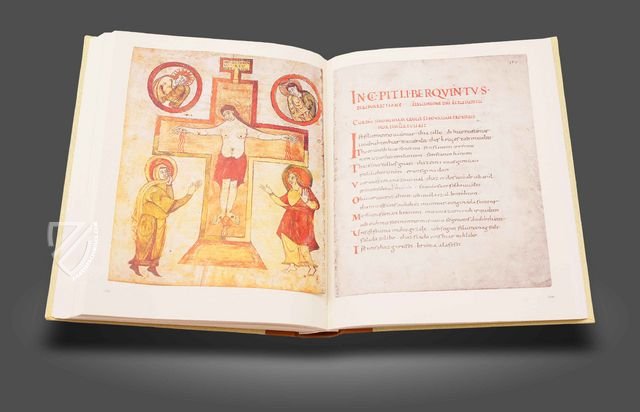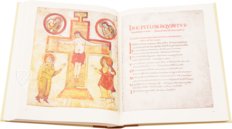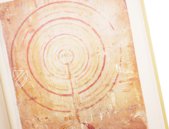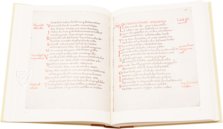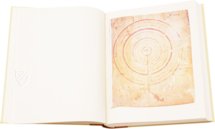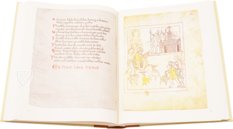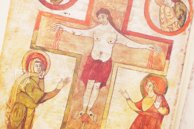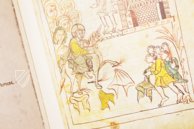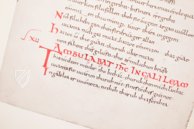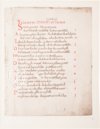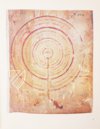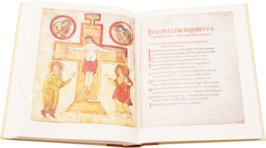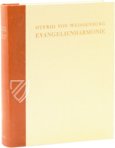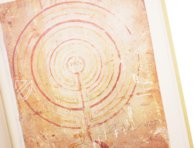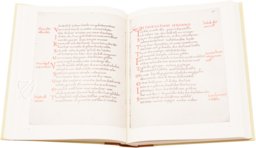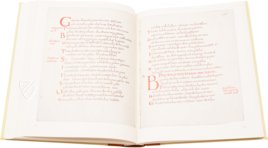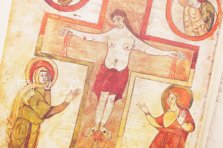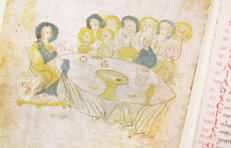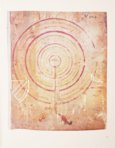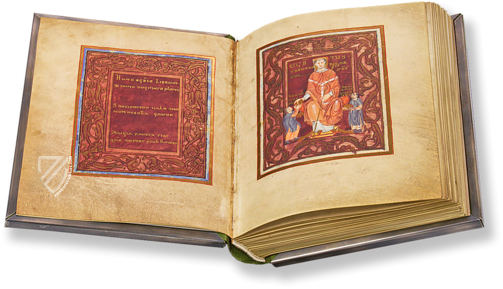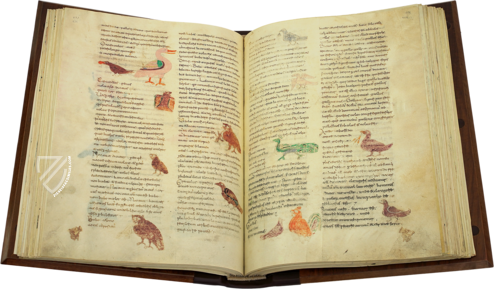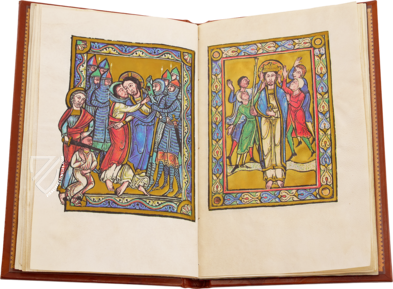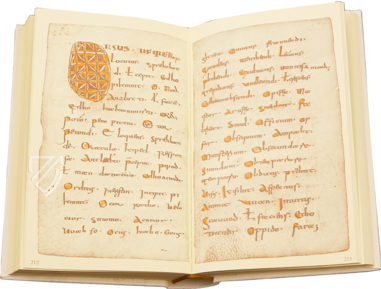Otfrid von Weißenburg: Gospel Harmony
(under 1,000€)
Being able to study under Rhabanus Maurus (c. 780–856) during the 9th century in Fulda is comparable to a stay in Oxford today. In any case, Otfrid von Weißenburg (c. 790–875) probably became a member of the court chapel after his stay, before he worked as a scholar in the monastery of Weißenburg in Alsace in the functions of a teacher, librarian, and exegete. It was there that he completed this Gospel Harmony before 871, a text that compiles a unified account of the life and ministry of Jesus from the Four Gospels and reflects a central interest of the Carolingian Renaissance, namely the understanding of the Christian salvific history through the creative study of the biblical texts. What distinguishes Otfrid from other authors is that he does not write in Latin, but in Old High German, thus becoming one of the first known German poets; he rhymes the total of 7,106 verses with internal rhymes in what was later named Otfridvers, thus replacing the Germanic Stabreim. Otfrid's hand is still tangible in the Codex Vindobonensis 2687: it is the copy that the magister himself used and corrected.
Otfrid von Weißenburg: Gospel Harmony
Otfried von Weißenburg (c. 790–875), who probably completed this Gospel book 'formed according to the pericopes of the church year ... after long work between 863 and 871', was a magister at the monastic school in Weißenburg or Wissembourg, today France, and was one of the many students of the influential scholar Hrabanus Maurus (around 780–856) from Fulda. He is the first author known by name whose German-language rhymes have survived. The fact that he worked in the vernacular is astonishing insofar as the primacy of Latin prevailed in the monastic context and the local South Rhine-Franconian dialect was still considered to be a agrestis lingua (i.e. feral language) for Otfried.
The Personal Testimony of a Great Scholar
The many surviving copies of the Old High German biblical epic testify to its great popularity. What is special about Cod. 2687 in the Austrian National Library is that it is the manuscript that Otfrid himself used and corrected. Through the numerous adjustments by the hand of the magister "we experience the development of the final text". This rearranges the canonical information on the life of Christ from the four Gospels in chronological order: the work is divided into five books, each of which tells of a period of Jesus' life. Otfrid thus made a courageous attempt to introduce readers who may not have mastered Latin to the world of the Good News. At the same time, this manuscript also contains instructions on how to read the text, whose innovative internal rhymes, later known as Otfridvers, were to replace the Germanic alliterative verse.
Scenes From the Vita Christi and the Difficult Path to Heaven
The four full-page illuminations are also noteworthy. The first page of the manuscript shows a round labyrinth, which is intended to show the viewer how difficult and lengthy the path to the kingdom of Heaven is. There are also colored pen and ink drawings of key scenes from the life of Christ: his Entry into Jerusalem, the Last Supper and the Crucifixion with Mary and John. While the pictures are probably by a single artist, the text was apparently written by four different scribes from the scriptorium in Weißenburg – plus Otfrid's own handwritten annotations. It is therefore probably a collaborative monastic work under the direction of the magister and author.
Dedicated to a King
As was common for religious writings of this kind at the time, Otfrid dedicated his work to important personalities of his day. The first dedication is addressed to Louis the German, King of East Francia ( r. 843–876), and is also written in Old High German. Interestingly, the other two dedication poems are written in Latin and are addressed to other clerics: Solomon I, Bishop of Constance († 871) and his fellow brethren Hartmuat and Werinbert. The manuscript also contains a copy of a Latin letter to Liutbert, Abbot of Weißenburg Abbey and later Archbishop of Mainz († 889), in which Otfrid explains his motivation and approach. All four texts allow the dating of the manuscript to be narrowed down to the period between 863 and 871. Where the codex was located after its creation and use by the magister is a so far unsolved mystery, as it only appears in sources for the first time in 1576 in Vienna, where it has remained ever since.
Codicology
- Alternative Titles
- Otfrid von Weißenburg: Evangelienharmonie
- Size / Format
- 388 pages / 25.0 × 21.0 cm
- Origin
- France
- Date
- 863–871
- Epochs
- Style
- Script
- Carolingian Minuscule
- Illustrations
- 4 full-page colored pen and ink drawings, incipits and initials in red display script
- Content
- Vita Christi, compiled from the four Gospels
- Artist / School
- Otfried von Weißenburg (ca. 800 – after 870) (compiler and scribe)
Otfrid von Weißenburg: Gospel Harmony
The Last Supper
Jesus is sitting at a large round table, which is completely covered in an opulent tablecloth and on which three loaves of bread are lying next to two goblets of wine. The large yellow (golden) vessel in which the Passover Lamb lies is also prominent. With a gesture of speech, Jesus turns to the 12 apostles who are sitting opposite him in two rows. He is probably telling them about the coming betrayal – some of them look at him dejectedly and gesticulate in disbelief, while Judas (in blue) clutches the edge of the table with his fingers.
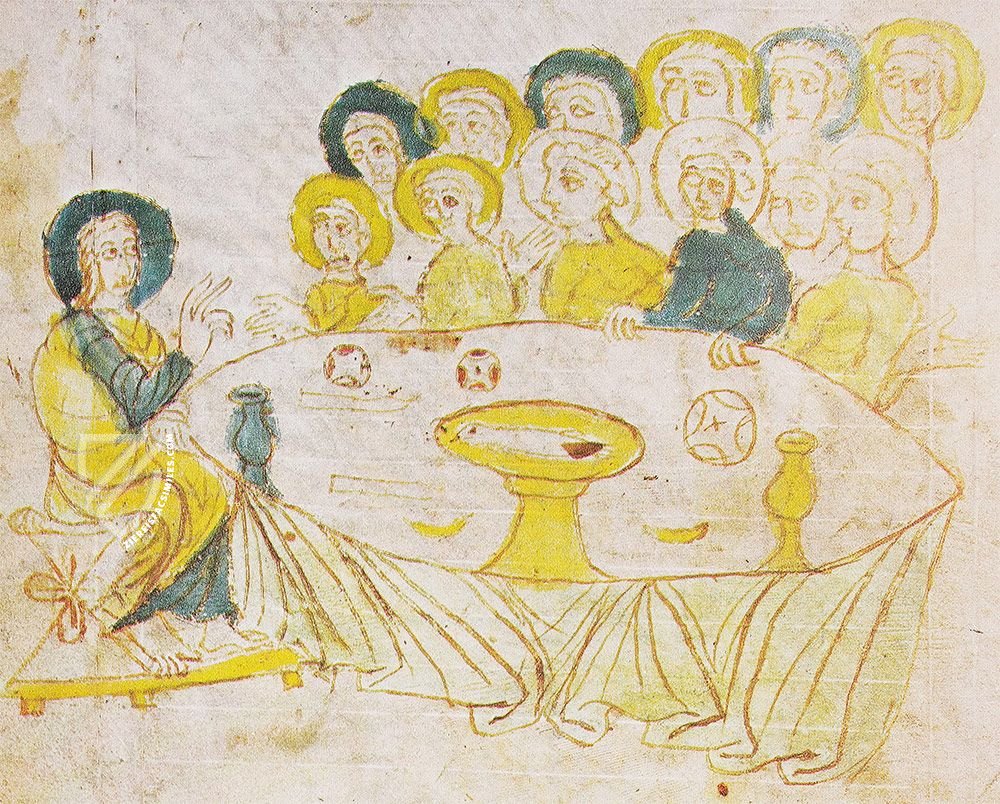
Otfrid von Weißenburg: Gospel Harmony
Crucifixion
Just covered in a red loincloth, Jesus is nailed to the broad Latin cross, the shape of which dominates the miniature. Blood runs from his wounds on his hands and feet and is collected by a chalice on the base of the Instrument of the Passion, emphasizing the Eucharistic interpretation of his death on the cross. The titulus is fully inscribed: "Iesus Nazarenus Rex Iudaeorum" (Jesus of Nazareth, King of the Jews).
Particularly impressive are the figures of Mary and John, who mourn their beloved son and mentor with gestures of despair, while Christ looks down peacefully on his mother in complete acceptance of his fate. He is flanked by Sol (sun) and Luna (moon), who appear grieving in two clipei in the sky and symbolize the all-encompassing significance of Jesus' sacrificial death.

#1 Otfrid von Weißenburg: Evangelienharmonie
Language: German
(under 1,000€)
- Treatises / Secular Books
- Apocalypses / Beatus
- Astronomy / Astrology
- Bestiaries
- Bibles / Gospels
- Chronicles / History / Law
- Geography / Maps
- Saints' Lives
- Islam / Oriental
- Judaism / Hebrew
- Single Leaf Collections
- Leonardo da Vinci
- Literature / Poetry
- Liturgical Manuscripts
- Medicine / Botany / Alchemy
- Music
- Mythology / Prophecies
- Psalters
- Other Religious Books
- Games / Hunting
- Private Devotion Books
- Other Genres
- Afghanistan
- Armenia
- Austria
- Belgium
- Belize
- Bosnia and Herzegovina
- China
- Colombia
- Costa Rica
- Croatia
- Cyprus
- Czech Republic
- Denmark
- Egypt
- El Salvador
- Ethiopia
- France
- Germany
- Greece
- Guatemala
- Honduras
- Hungary
- India
- Iran
- Iraq
- Israel
- Italy
- Japan
- Jordan
- Kazakhstan
- Kyrgyzstan
- Lebanon
- Liechtenstein
- Luxembourg
- Mexico
- Morocco
- Netherlands
- Palestine
- Panama
- Peru
- Poland
- Portugal
- Romania
- Russia
- Serbia
- Spain
- Sri Lanka
- Sweden
- Switzerland
- Syria
- Tajikistan
- Turkey
- Turkmenistan
- Ukraine
- United Kingdom
- United States
- Uzbekistan
- Vatican City
- A. Oosthoek, van Holkema & Warendorf
- Aboca Museum
- Ajuntament de Valencia
- Akademie Verlag
- Akademische Druck- u. Verlagsanstalt (ADEVA)
- Aldo Ausilio Editore - Bottega d’Erasmo
- Alecto Historical Editions
- Alkuin Verlag
- Almqvist & Wiksell
- Amilcare Pizzi
- Andreas & Andreas Verlagsbuchhandlung
- Archa 90
- Archiv Verlag
- Archivi Edizioni
- Arnold Verlag
- ARS
- Ars Magna
- ArtCodex
- AyN Ediciones
- Azimuth Editions
- Badenia Verlag
- Bärenreiter-Verlag
- Belser Verlag
- Belser Verlag / WK Wertkontor
- Benziger Verlag
- Bernardinum Wydawnictwo
- BiblioGemma
- Biblioteca Apostolica Vaticana (Vaticanstadt, Vaticanstadt)
- Bibliotheca Palatina Faksimile Verlag
- Bibliotheca Rara
- Boydell & Brewer
- Bramante Edizioni
- Bredius Genootschap
- Brepols Publishers
- British Library
- C. Weckesser
- Caixa Catalunya
- Canesi
- CAPSA, Ars Scriptoria
- Caratzas Brothers, Publishers
- Carus Verlag
- Casamassima Libri
- Centrum Cartographie Verlag GmbH
- Chavane Verlag
- Christian Brandstätter Verlag
- Circulo Cientifico
- Club Bibliófilo Versol
- Club du Livre
- CM Editores
- Collegium Graphicum
- Collezione Apocrifa Da Vinci
- Comissão Nacional para as Comemorações dos Descobrimentos Portugueses
- Coron Verlag
- Corvina
- CTHS
- D. S. Brewer
- Damon
- De Agostini/UTET
- De Nederlandsche Boekhandel
- De Schutter
- Deuschle & Stemmle
- Deutscher Verlag für Kunstwissenschaft
- DIAMM
- Droz
- E. Schreiber Graphische Kunstanstalten
- Ediciones Boreal
- Ediciones Grial
- Ediclube
- Edições Inapa
- Edilan
- Editalia
- Edition Deuschle
- Edition Georg Popp
- Edition Leipzig
- Edition Libri Illustri
- Editiones Reales Sitios S. L.
- Éditions de l'Oiseau Lyre
- Editions Medicina Rara
- Editorial Casariego
- Editorial Mintzoa
- Editrice Antenore
- Editrice Velar
- Edizioni Edison
- Egeria, S.L.
- Eikon Editores
- Electa
- Emery Walker Limited
- Enciclopèdia Catalana
- Eos-Verlag
- Ephesus Publishing
- Ernst Battenberg
- Eugrammia Press
- Extraordinary Editions
- Fackelverlag
- Facsimila Art & Edition
- Facsimile Editions Ltd.
- Facsimilia Art & Edition Ebert KG
- Faksimile Verlag
- Feuermann Verlag
- Folger Shakespeare Library
- Franco Cosimo Panini Editore
- Friedrich Wittig Verlag
- Fundación Hullera Vasco-Leonesa
- G. Braziller
- Gabriele Mazzotta Editore
- Gebr. Mann Verlag
- Gesellschaft für graphische Industrie
- Getty Research Institute
- Giovanni Domenico de Rossi
- Giunti Editore
- Graffiti
- Grafica European Center of Fine Arts
- Guido Pressler
- Guillermo Blazquez
- Gustav Kiepenheuer
- H. N. Abrams
- Harrassowitz
- Harvard University Press
- Helikon
- Hendrickson Publishers
- Henning Oppermann
- Herder Verlag
- Hes & De Graaf Publishers
- Hoepli
- Holbein-Verlag
- Houghton Library
- Hugo Schmidt Verlag
- Idion Verlag
- Il Bulino, edizioni d'arte
- ILte
- Imago
- Insel Verlag
- Insel-Verlag Anton Kippenberger
- Instituto de Estudios Altoaragoneses
- Instituto Nacional de Antropología e Historia
- Introligatornia Budnik Jerzy
- Istituto dell'Enciclopedia Italiana - Treccani
- Istituto Ellenico di Studi Bizantini e Postbizantini
- Istituto Geografico De Agostini
- Istituto Poligrafico e Zecca dello Stato
- Italarte Art Establishments
- Jan Thorbecke Verlag
- Johnson Reprint Corporation
- Josef Stocker
- Josef Stocker-Schmid
- Jugoslavija
- Karl W. Hiersemann
- Kasper Straube
- Kaydeda Ediciones
- Kindler Verlag / Coron Verlag
- Kodansha International Ltd.
- Konrad Kölbl Verlag
- Kurt Wolff Verlag
- La Liberia dello Stato
- La Linea Editrice
- La Meta Editore
- Lambert Schneider
- Landeskreditbank Baden-Württemberg
- Leo S. Olschki
- Les Incunables
- Liber Artis
- Library of Congress
- Libreria Musicale Italiana
- Lichtdruck
- Lito Immagine Editore
- Lumen Artis
- Lund Humphries
- M. Moleiro Editor
- Maison des Sciences de l'homme et de la société de Poitiers
- Manuscriptum
- Martinus Nijhoff
- Maruzen-Yushodo Co. Ltd.
- MASA
- Massada Publishers
- McGraw-Hill
- Metropolitan Museum of Art
- Militos
- Millennium Liber
- Müller & Schindler
- Nahar - Stavit
- Nahar and Steimatzky
- National Library of Wales
- Neri Pozza
- Nova Charta
- Oceanum Verlag
- Odeon
- Orbis Mediaevalis
- Orbis Pictus
- Österreichische Staatsdruckerei
- Oxford University Press
- Pageant Books
- Parzellers Buchverlag
- Patrimonio Ediciones
- Pattloch Verlag
- PIAF
- Pieper Verlag
- Plon-Nourrit et cie
- Poligrafiche Bolis
- Presses Universitaires de Strasbourg
- Prestel Verlag
- Princeton University Press
- Prisma Verlag
- Priuli & Verlucca, editori
- Pro Sport Verlag
- Propyläen Verlag
- Pytheas Books
- Quaternio Verlag Luzern
- Reales Sitios
- Recht-Verlag
- Reichert Verlag
- Reichsdruckerei
- Reprint Verlag
- Riehn & Reusch
- Roberto Vattori Editore
- Rosenkilde and Bagger
- Roxburghe Club
- Salerno Editrice
- Saltellus Press
- Sandoz
- Sarajevo Svjetlost
- Schöck ArtPrint Kft.
- Schulsinger Brothers
- Scolar Press
- Scrinium
- Scripta Maneant
- Scriptorium
- Shazar
- Siloé, arte y bibliofilia
- SISMEL - Edizioni del Galluzzo
- Sociedad Mexicana de Antropología
- Société des Bibliophiles & Iconophiles de Belgique
- Soncin Publishing
- Sorli Ediciones
- Stainer and Bell
- Studer
- Styria Verlag
- Sumptibus Pragopress
- Szegedi Tudomànyegyetem
- Taberna Libraria
- Tarshish Books
- Taschen
- Tempus Libri
- Testimonio Compañía Editorial
- Thames and Hudson
- The Clear Vue Publishing Partnership Limited
- The Facsimile Codex
- The Folio Society
- The Marquess of Normanby
- The Richard III and Yorkist History Trust
- Tip.Le.Co
- TouchArt
- TREC Publishing House
- TRI Publishing Co.
- Trident Editore
- Tuliba Collection
- Typis Regiae Officinae Polygraphicae
- Union Verlag Berlin
- Universidad de Granada
- University of California Press
- University of Chicago Press
- Urs Graf
- Vallecchi
- Van Wijnen
- VCH, Acta Humaniora
- VDI Verlag
- VEB Deutscher Verlag für Musik
- Verlag Anton Pustet / Andreas Verlag
- Verlag Bibliophile Drucke Josef Stocker
- Verlag der Münchner Drucke
- Verlag für Regionalgeschichte
- Verlag Styria
- Vicent Garcia Editores
- W. Turnowski Ltd.
- W. Turnowsky
- Waanders Printers
- Wiener Mechitharisten-Congregation (Wien, Österreich)
- Wissenschaftliche Buchgesellschaft
- Wissenschaftliche Verlagsgesellschaft
- Wydawnictwo Dolnoslaskie
- Xuntanza Editorial
- Zakład Narodowy
- Zollikofer AG

